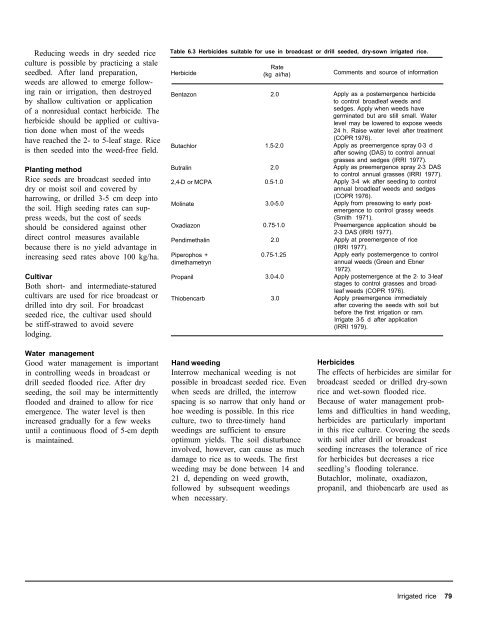A handbbok on Weed Control in Rice.pdf
A handbbok on Weed Control in Rice.pdf
A handbbok on Weed Control in Rice.pdf
Create successful ePaper yourself
Turn your PDF publications into a flip-book with our unique Google optimized e-Paper software.
Reduc<strong>in</strong>g weeds <strong>in</strong> dry seeded rice<br />
culture is possible by practic<strong>in</strong>g a stale<br />
seedbed. After land preparati<strong>on</strong>,<br />
weeds are allowed to emerge follow-<br />
<strong>in</strong>g ra<strong>in</strong> or irrigati<strong>on</strong>, then destroyed<br />
by shallow cultivati<strong>on</strong> or applicati<strong>on</strong><br />
of a n<strong>on</strong>residual c<strong>on</strong>tact herbicide. The<br />
herbicide should be applied or cultiva-<br />
ti<strong>on</strong> d<strong>on</strong>e when most of the weeds<br />
have reached the 2- to 5-leaf stage. <strong>Rice</strong><br />
is then seeded <strong>in</strong>to the weed-free field.<br />
Plant<strong>in</strong>g method<br />
<strong>Rice</strong> seeds are broadcast seeded <strong>in</strong>to<br />
dry or moist soil and covered by<br />
harrow<strong>in</strong>g, or drilled 3-5 cm deep <strong>in</strong>to<br />
the soil. High seed<strong>in</strong>g rates can sup-<br />
press weeds, but the cost of seeds<br />
should be c<strong>on</strong>sidered aga<strong>in</strong>st other<br />
direct c<strong>on</strong>trol measures available<br />
because there is no yield advantage <strong>in</strong><br />
<strong>in</strong>creas<strong>in</strong>g seed rates above 100 kg/ha.<br />
Cultivar<br />
Both short- and <strong>in</strong>termediate-statured<br />
cultivars are used for rice broadcast or<br />
drilled <strong>in</strong>to dry soil. For broadcast<br />
seeded rice, the cultivar used should<br />
be stiff-strawed to avoid severe<br />
lodg<strong>in</strong>g.<br />
Water management<br />
Good water management is important<br />
<strong>in</strong> c<strong>on</strong>troll<strong>in</strong>g weeds <strong>in</strong> broadcast or<br />
drill seeded flooded rice. After dry<br />
seed<strong>in</strong>g, the soil may be <strong>in</strong>termittently<br />
flooded and dra<strong>in</strong>ed to allow for rice<br />
emergence. The water level is then<br />
<strong>in</strong>creased gradually for a few weeks<br />
until a c<strong>on</strong>t<strong>in</strong>uous flood of 5-cm depth<br />
is ma<strong>in</strong>ta<strong>in</strong>ed.<br />
Table 6.3 Herbicides suitable for use <strong>in</strong> broadcast or drill seeded, dry-sown irrigated rice.<br />
Herbicide<br />
Bentaz<strong>on</strong><br />
Butachlor<br />
Butral<strong>in</strong><br />
2,4-D or MCPA<br />
Mol<strong>in</strong>ate<br />
Oxadiaz<strong>on</strong><br />
Pendimethal<strong>in</strong><br />
Piperophos +<br />
dimethametryn<br />
Propanil<br />
Thiobencarb<br />
Rate<br />
(kg ai/ha)<br />
2.0<br />
1.5-2.0<br />
2.0<br />
0.5-1.0<br />
3.0-5.0<br />
0.75-1.0<br />
2.0<br />
0.75-1.25<br />
3.0-4.0<br />
3.0<br />
Hand weed<strong>in</strong>g<br />
Interrow mechanical weed<strong>in</strong>g is not<br />
possible <strong>in</strong> broadcast seeded rice. Even<br />
when seeds are drilled, the <strong>in</strong>terrow<br />
spac<strong>in</strong>g is so narrow that <strong>on</strong>ly hand or<br />
hoe weed<strong>in</strong>g is possible. In this rice<br />
culture, two to three-timely hand<br />
weed<strong>in</strong>gs are sufficient to ensure<br />
optimum yields. The soil disturbance<br />
<strong>in</strong>volved, however, can cause as much<br />
damage to rice as to weeds. The first<br />
weed<strong>in</strong>g may be d<strong>on</strong>e between 14 and<br />
21 d, depend<strong>in</strong>g <strong>on</strong> weed growth,<br />
followed by subsequent weed<strong>in</strong>gs<br />
when necessary.<br />
Comments and source of <strong>in</strong>formati<strong>on</strong><br />
Apply as a postemergence herbicide<br />
to c<strong>on</strong>trol broadleaf weeds and<br />
sedges. Apply when weeds have<br />
germ<strong>in</strong>ated but are still small. Water<br />
level may be lowered to expose weeds<br />
24 h. Raise water level after treatment<br />
(COPR 1976).<br />
Apply as preemergence spray 0-3 d<br />
after sow<strong>in</strong>g (DAS) to c<strong>on</strong>trol annual<br />
grasses and sedges (IRRI 1977).<br />
Apply as preemergence spray 2-3 DAS<br />
to c<strong>on</strong>trol annual grasses (IRRI 1977).<br />
Apply 3-4 wk after seed<strong>in</strong>g to c<strong>on</strong>trol<br />
annual broadleaf weeds and sedges<br />
(COPR 1976).<br />
Apply from presow<strong>in</strong>g to early post-<br />
emergence to c<strong>on</strong>trol grassy weeds<br />
(Smith 1971).<br />
Preemergence applicati<strong>on</strong> should be<br />
2-3 DAS (IRRI 1977).<br />
Apply at preemergence of rice<br />
(IRRI 1977).<br />
Apply early postemergence to c<strong>on</strong>trol<br />
annual weeds (Green and Ebner<br />
1972).<br />
Apply postemergence at the 2- to 3-leaf<br />
stages to c<strong>on</strong>trol grasses and broad-<br />
leaf weeds (COPR 1976).<br />
Apply preemergence immediately<br />
after cover<strong>in</strong>g the seeds with soil but<br />
before the first irrigati<strong>on</strong> or ram.<br />
Irrigate 3-5 d after applicati<strong>on</strong><br />
(IRRI 1979).<br />
Herbicides<br />
The effects of herbicides are similar for<br />
broadcast seeded or drilled dry-sown<br />
rice and wet-sown flooded rice.<br />
Because of water management prob-<br />
lems and difficulties <strong>in</strong> hand weed<strong>in</strong>g,<br />
herbicides are particularly important<br />
<strong>in</strong> this rice culture. Cover<strong>in</strong>g the seeds<br />
with soil after drill or broadcast<br />
seed<strong>in</strong>g <strong>in</strong>creases the tolerance of rice<br />
for herbicides but decreases a rice<br />
seedl<strong>in</strong>g’s flood<strong>in</strong>g tolerance.<br />
Butachlor, mol<strong>in</strong>ate, oxadiaz<strong>on</strong>,<br />
propanil, and thiobencarb are used as<br />
Irrigated rice 79











